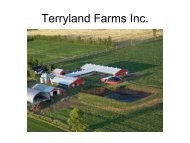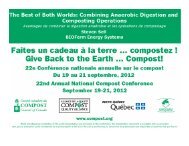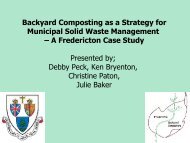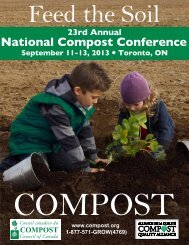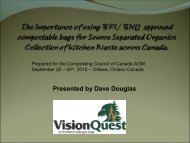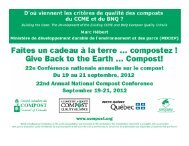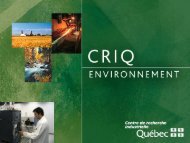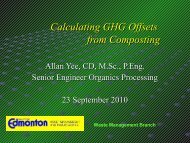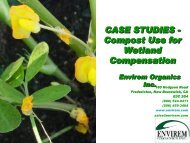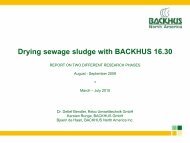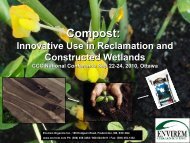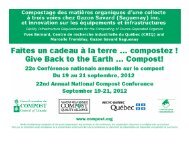Mortality Disposal and its Implications on Human, Animal and ...
Mortality Disposal and its Implications on Human, Animal and ...
Mortality Disposal and its Implications on Human, Animal and ...
- No tags were found...
Create successful ePaper yourself
Turn your PDF publications into a flip-book with our unique Google optimized e-Paper software.
Do Burial <str<strong>on</strong>g>and</str<strong>on</strong>g> Composting Have the SameWater- NutrientsBODTOCPathogensEnvir<strong>on</strong>mental <str<strong>on</strong>g>Implicati<strong>on</strong>s</str<strong>on</strong>g>?Soil-Air-NutrientsPathogensOdor Emissi<strong>on</strong>sTraffic- NoiseCornell Waste Management Institutecwmi.css.cornell.edu
Do Drugs Used in Livestock Producti<strong>on</strong>Behave Differently in the Carcasses ofComposted or Buried <strong>Animal</strong>s?Euthanasia Drugs: BarbituratesN<strong>on</strong>-Steroidal Anti-InflammatoryDrugs (NSAIDs)WormersCornell Waste Management Institutecwmi.css.cornell.edu
Composting, D<strong>on</strong>e Properly, is Safe for <strong>Human</strong>s,<strong>Animal</strong>s <str<strong>on</strong>g>and</str<strong>on</strong>g> the Envir<strong>on</strong>mentSITE SELECTIONCARBON SOURCESMake sure you are not close to wells,streams, water bodies. Check depthto groundwater. Look for plants thatindicate wet areas.Cornell Waste Management Institutecwmi.css.cornell.eduNot all carb<strong>on</strong> sources are created equal.Carb<strong>on</strong> sources include: Wood Chips,Shavings, Sawdust, Refused feed, SpoiledSilage, Chopped Cornstalk, Nut Hulls,Partially Composted Material-HOT
<str<strong>on</strong>g>Mortality</str<strong>on</strong>g> Composting StepsLay 24-in bed of bulky, absorbingorganic material c<strong>on</strong>taining somesizeable pieces. Place animal inthe center of the bed.Lance the rumenCover the carcass with dry, highcarb<strong>on</strong>material.Cornell Waste Management Institutecwmi.css.cornell.edu
This method allows for good aerati<strong>on</strong> which createshigh temperatures, destroys pathogens <str<strong>on</strong>g>and</str<strong>on</strong>g> createsa biofilter to alleviate odors.Cornell Waste Management Institutecwmi.css.cornell.edu
Some Best Management PracticesIncorporate dead stock in atimely fashi<strong>on</strong>.Large, poorly shaped piles are notefficientCornell Waste Management Institutecwmi.css.cornell.edu
Some Best Management Practices: Ground <str<strong>on</strong>g>and</str<strong>on</strong>g>Surface Water Protecti<strong>on</strong>Filter StripsCompost Berms <str<strong>on</strong>g>and</str<strong>on</strong>g> SocksBerms for Diversi<strong>on</strong> Off-siteGrading/ Slope 1-2%Collecti<strong>on</strong> Lago<strong>on</strong>sCollecti<strong>on</strong> TanksSite MaintenanceLAGOONBERMCOMPOST BERMPhoto by Bob RynkCornell Waste Management Institutecwmi.css.cornell.eduMOWED SITE
Above Ground BurialThree Research ProjectsLeachate Qualityduring CompostingCornell Waste Management Institutecwmi.css.cornell.eduFate of Drugs inComposting
Above Ground Burial Study•Dimensi<strong>on</strong>s are 30’ wide by 15’ deep with3--54” c<strong>on</strong>tainment walls•The pad has a 1% slope to the west wallwith four 4” pipes incorporated fordraining leachate toward a vegetated filterstrip.• Very little carb<strong>on</strong> was used, <str<strong>on</strong>g>and</str<strong>on</strong>g> thec<strong>on</strong>tainment was packed with carcasses.Cornell Waste Management Institutecwmi.css.cornell.edu
C:N Ratio, Number of <strong>Animal</strong>s, GoodCoverCornell Waste Management Institutecwmi.css.cornell.edu
Run-Off from Above Ground BurialCornell Waste Management Institutecwmi.css.cornell.edu
Next seas<strong>on</strong> when Using it Correctly???Cornell Waste Management Institutecwmi.css.cornell.edu
Leachate Quality Results:Above Ground BurialDate TKN (mg/l) NH4-N(mg/l)Cornell Waste Management Institutecwmi.css.cornell.eduP (mg/l)BOD(mg/l)TOC (mg/l)06/02/08 3,300 1,100 70 4,700 7,70009/29/08 640 52 930 4,60010/02/08 6,000 4,200 440 21,000 74011/12/08 3,000 1,800 92 3,500 8,100Date pH NO3-N(mg/l)Chloride(mg/l)Fecal Coliform(log10 cfu/ml)06/02/08 7.9 3.8 1,900 3.009/29/08 8.4 15.0 2,300 < 2.010/02/08 6.4 31.0 710 > 3.011/12/08 8.3 16.6 2,000 < 2.0
Cornell Waste Management Institutecwmi.css.cornell.eduWell Used Bins
Leachate Quality Assessment Study2- 15’ x 8’ rectangles were marked out;holes were drilled at the point ofcollecti<strong>on</strong> <str<strong>on</strong>g>and</str<strong>on</strong>g> 5-gall<strong>on</strong> buckets lined withgarbage bags were placed in each hole.Plots were curbed with wooden <str<strong>on</strong>g>and</str<strong>on</strong>g> steelbeams that were 6” tall.Heavy 6 mil black plastic was used to linethe plots.24” base layer of woodchips was laid ineach of the plotsCornell Waste Management Institutecwmi.css.cornell.edu
Leachate Quality Assessment StudyTwo deer were placed <strong>on</strong> the woodchipsas the first layer in the plot <strong>on</strong> the westend. The plot <strong>on</strong> the east end was“woodchips <strong>on</strong>ly”.Data logger temperature probes wereplaced in both piles.Riverhead, NY – Blue <str<strong>on</strong>g>and</str<strong>on</strong>g> Green funding12” of woodchips were laid <strong>on</strong> top to cover the first deer layer2 more deer were placed in the 2 nd layer in the road-kill pile.Both piles were covered with an additi<strong>on</strong>al 24” of woodchips.Cornell Waste Management Institutecwmi.css.cornell.edu
Cornell Waste Management Institutecwmi.css.cornell.eduLeachate Quality Results:Road-kill Compost versus WoodchipsOnlyTKN (mg/l)NH4-N(mg/l)P (mg/l) BOD (mg/l) TOC (mg/l)Date Deer Chips Deer Chips Deer Chips Deer Chips Deer Chips04/14/08 703 36 213 11 44 10 4,067 487 1,73304/29/08 75 7 38 1 17 1 333 48 230 3605/19/08 14 13 3 2 3 2 27 24 95 16306/06/08 32 16 9 5 6 2 101 47 177 17373
Comparis<strong>on</strong> of Nitrogen (TKN) in <str<strong>on</strong>g>Mortality</str<strong>on</strong>g> Compost<str<strong>on</strong>g>and</str<strong>on</strong>g> Above Ground BurialCompostAbove Ground BurialCornell Waste Management Institutecwmi.css.cornell.eduX-axis is 10 times the order ofmagnitude here versus the compost.
Comparis<strong>on</strong> of Amm<strong>on</strong>ia Nitrogen (NH4-N) in<str<strong>on</strong>g>Mortality</str<strong>on</strong>g> Compost <str<strong>on</strong>g>and</str<strong>on</strong>g> Above Ground BurialCompostAbove Ground BurialCornell Waste Management Institutecwmi.css.cornell.eduX-axis is 10 times the order ofmagnitude here versus the compost.
Comparis<strong>on</strong> of Biological Oxygen Dem<str<strong>on</strong>g>and</str<strong>on</strong>g> (BOD) in<str<strong>on</strong>g>Mortality</str<strong>on</strong>g> Compost <str<strong>on</strong>g>and</str<strong>on</strong>g> Above Ground BurialCompostAbove Ground BurialCornell Waste Management Institutecwmi.css.cornell.eduX-axis is 10 times the order ofmagnitude here versus the compost.
Fate of Drugs StudyA 20’ x 21’ piece of 10 mil plasticsheeting was laid down. A hole was dugat the low end of the pad, under theplastic for leachate/runoff collecti<strong>on</strong>.A 24” bed of wood chips was laid <strong>on</strong> theplastic.A 27 year old 1000 lb Appaloosa wasinjected with 120 ml Fatal Plus at 390mg/ml Pentobarbital Sodium.Cornell Waste Management Institutecwmi.css.cornell.edu
Fate of Drugs StudyThe liver was removed, cut into pieces<str<strong>on</strong>g>and</str<strong>on</strong>g> put back in the horse for retrieval atvarious intervals.A separate 4 foot hole was dug in whichliver samples were placed to simulateburial.Data logger temperature probes wereplaced in both the compost pile <str<strong>on</strong>g>and</str<strong>on</strong>g> inthe “burial hole” to record hourlytemperature.Cornell Waste Management Institutecwmi.css.cornell.edu
Fate of Drugs StudyThe horse was then covered with 24” ofwood chips, <str<strong>on</strong>g>and</str<strong>on</strong>g> the plastic liner wastightened by rolling it over <str<strong>on</strong>g>and</str<strong>on</strong>g> underwooden fence posts.Cornell Waste Management Institutecwmi.css.cornell.edu
Temperature <str<strong>on</strong>g>and</str<strong>on</strong>g> RainfallCornell Waste Management Institutecwmi.css.cornell.edu
Pentobarbital (ppm) in Liver SamplesDecay rate of pentobarbital:In the pile – 2.2% per dayIn the burial hole – 18.4% per dayCornell Waste Management Institutecwmi.css.cornell.edu
Pentobarbital in LeachateDecay rate of pentobarbital: 20% per dayCornell Waste Management Institutecwmi.css.cornell.edu
Phenylbutaz<strong>on</strong>e (ppb) in Liver SamplesDecay rate of phenylbutaz<strong>on</strong>e:In the pile – 16.0% per dayIn the burial hole – 29.8% per dayCornell Waste Management Institutecwmi.css.cornell.edu
<str<strong>on</strong>g>Mortality</str<strong>on</strong>g> CompostingWhen d<strong>on</strong>e properly, mortality compostingprotects ground <str<strong>on</strong>g>and</str<strong>on</strong>g> surface water.Composting of euthanizedlivestock appears tobreakdown both pentobarbital<str<strong>on</strong>g>and</str<strong>on</strong>g> phenylbutaz<strong>on</strong>e, thusrendering the finished productsafe for wildlife <str<strong>on</strong>g>and</str<strong>on</strong>g> domesticanimals.Cornell Waste Management Institutecwmi.css.cornell.eduHorse pile opened after 7 m<strong>on</strong>ths of composting
C<strong>on</strong>clusi<strong>on</strong>s• There was still Pentobarbital in the leachate<str<strong>on</strong>g>and</str<strong>on</strong>g> in compost samples (0.17ppm). Rate wasvery low but we were not sure if it degradedor if filtered into the soil below.Cornell Waste Management Institutecwmi.css.cornell.edu
Sec<strong>on</strong>d Trial• Trial with a horse enveloped in woodchipseuthanized but left intact with leachatecollecti<strong>on</strong> in a woodchip layer- leachate <str<strong>on</strong>g>and</str<strong>on</strong>g>compost samples are being taken.<str<strong>on</strong>g>and</str<strong>on</strong>g>• Euthanized intact cow placed in a pile soilsamples will be taken.Cornell Waste Management Institutecwmi.css.cornell.edu
Cornell Waste Management Institutecwmi.css.cornell.eduQuesti<strong>on</strong>s?



